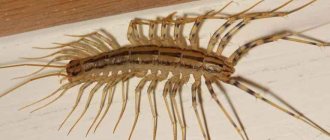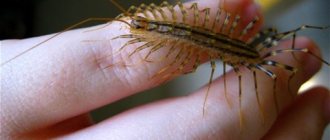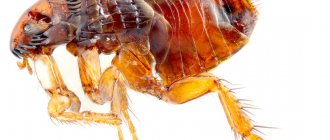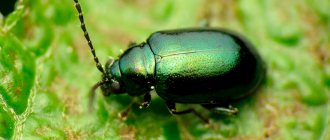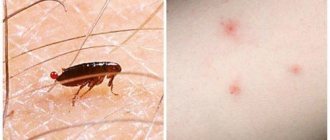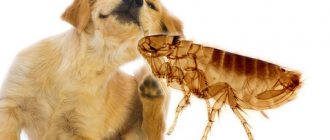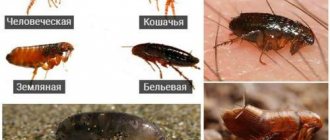Fleas are harmful parasites that prefer to live on the body of warm-blooded animals with fur. But in addition to these types of insects, there are species that drink human blood.
The human flea originated in South America and then spread throughout the world. This type of parasite does not live permanently on the human body, but only feeds on its blood. When the bloodsucker is satisfied, he returns to his hiding place.
The bites of wingless insects are very dangerous for humans, as the pests carry a lot of infections. Therefore, it is important to know what a human flea looks like and how it penetrates into a home and what methods can be used to destroy it.
Are there human fleas?
Fleas are insects that lead a parasitic lifestyle. Bloodsuckers are not very picky about what they eat, especially when they feel hungry.
Do fleas live on humans? Under normal conditions, wingless ones choose the blood of a dog or cat. Small parasites bite humans if they have no other source of food.
However, there is one type of blood-sucking parasite from the Pulex Irritans family that bites humans. The human flea prefers to drink the blood of people, but if they are not nearby, then it can live on the body of almost any mammal.
It is noteworthy that in addition to Pulex Irritans, more than 1,500 species of fleas can consume human blood. But most of them parasitize a certain species of bird or animal.
Most often, humans are bitten by these types of wingless bloodsuckers.:
- Rabbit.
- Feline.
- Rat.
- Canine.
These types of parasites bite humans when there are no hosts nearby. For example, rabbit bloodsuckers often attack hunters.
Prevention
Preventive measures against the appearance of fleas in the apartment are simple, but require regularity and attention.
It is necessary to carefully inspect all surfaces and cover any cracks if any have formed in window, doorways or floors. It is advisable not to allow children to bring other people's animals.
When walking with pets, put a flea collar on them and exclude contact with street stray animals. All accessories from the corner where the dog sleeps are periodically shaken out, ventilated, and washed.
When carrying out general cleaning, it is useful to use one of the herbal infusions that have flea-repellent properties.
Appearance of a flea
If pinpoint bites appear on the human body, and small insects are jumping around the house, in order to determine their species, you need to understand what human fleas look like. Human parasites are very similar to other types of blood-sucking, wingless insects.
The pests are very small, they have a flattened body . Parasites have a small head and no wings. The size of an adult insect is about 3 mm.
A bloodsucker that bites a person has 6 legs, and its hind legs are more developed. This gives him the ability to jump over a long distance (1.5 m).
An insect that prefers to suck human blood has a developed oral apparatus. This allows him to inject and easily draw the red liquid from the vessels.
Enemy specifics
Fleas multiply quickly and it is enough for one individual to appear so that in a short period of time there is a massive spread of blood-sucking insects. A flea can live alone for a long time, without a permanent place of residence in the form of skin.
The flea has a flattened body 5-7 mm long. There are many hairs and antennae on it, with the help of which it clings to skin and clothing. The color of fleas may vary in shade. It is usually maroon or black in color.
Fleas can jump to great heights. Three pairs of legs allow this trick to be performed. Sometimes jumps reach 2 meters in height.
Fleas leave bites on the body of animals and humans that cause severe itching. By biting, the flea sucks out blood, but before that it lets its saliva under the skin. It blocks blood clotting and the insect can feed without worrying that the blood will stop flowing. Such bites can provoke allergic reactions or even infection, since fleas are carriers of infectious diseases.
How to tell if there are fleas
The presence of a blood-sucking parasite can be determined by examining its bites. Some people think that fleas live on a person's head. But in reality, human insects feel absolutely comfortable when they land on the face, arms, neck, back, legs or stomach.
The bites of wingless parasites are very painful, so they are well felt.
Symptoms of fleas in humans:
- the presence of red spots at the site of the bite.
- Purple spots become swollen and itchy.
- When scratching, wounds and abrasions appear.
- If infection penetrates into the affected areas, ulcers form.
When a human flea bites the scalp, unlike lice, its bite is painful. At the same time, the parasite that selects human blood is more mobile and jumps well.
Recommendations after processing is completed
After disinfestation is carried out independently or by professionals, people may experience symptoms of poisoning of varying severity. To avoid this, after processing is completed, you must follow some rules:
- A few hours after treatment, the room should be well ventilated;
- It is worth washing door handles and other objects that often come into contact with human hands. It is also necessary to rinse all dishes well;
- Hands should be washed with special care before eating;
- The floor should be washed no earlier than a couple of days after completion of all insect control measures.
These rules will help avoid poisoning the human body. Will increase processing efficiency. They will prolong the effect of its action.
How to get rid of insects
There are many ways to remove fleas from humans. So, if there are animals in the house, then it is necessary to treat the pets’ fur with a special shampoo or products. For prevention, you should put a special collar on your cat or dog.
It is recommended to do a thorough cleaning of the entire house. It is recommended to thoroughly clean carpets, furniture and bedding where animals lie.
Exposure to temperatures will help get rid of wingless ones. You can wash things in the hottest water possible or ventilate the room on a sunny day.
Freezing will also help eliminate human parasites. Therefore, in winter it is necessary to ventilate the apartment as often as possible. But this method is not suitable for a person prone to colds.
Effective methods for removing pests that suck human blood are the use of chemicals or folk remedies. If the effectiveness of such measures is low, they resort to the services of professional exterminators.
Chemicals
Since fleas feed only on blood, there is a small list of means to eliminate them. For example, this type of parasite does not eat bait.
To combat fleas in humans, 2 types of products are used:
| Type of chemical | Action | Name |
| Aerosols | They enter the body of bloodsuckers along with the air. They have a quick effect and do not destroy larvae or eggs. | Gardex, OFF-Extreme, Gall-Rat, Bee Ban |
| Suspensions and powders | Active components penetrate the skin of pests. These products are considered more effective than sprays and have a long-lasting effect. | Cypermethrin, Get, Tetramethrin-pyrethroid |
How to get rid of fleas on the human body and how to repel fleas from a person? Since Pulex irritans is not constantly present on its host, there is no need to use potent agents to destroy them.
But to repel pests, you can treat the skin with preparations whose smell repels human insects (clove extract, lemon extract, wild garlic solution).
Folk remedies
If a person has fleas, it is important to know how to protect yourself from them using folk remedies. There are many ways to get wingless pests out of your home.
The most effective and popular means are soda, salt, pine shavings, yeast, garlic and herbs. Moreover, any of these components is absolutely safe for humans.
Soda and salt are combined in equal quantities. The mixture is scattered in corners and other places where parasites live. After a day, you should vacuum everything thoroughly.
Coniferous needles and wormwood have a pronounced antiparasitic effect. Dry plants are scattered in front of the entrance to the house and placed in any cracks. This will prevent pests from entering the home and getting on the human body.
Chopped garlic is mixed with brewer's yeast. The composition is applied to the floor and baseboards. After 10 hours, the treated areas are vacuumed and washed.
Herbal infusions are considered effective remedies against wingless insects . Most of all, human fleas (and not only) are repelled by the smell of eucalyptus, lavender, tansy and wormwood. All plants are mixed in equal quantities, poured with water, and boiled. The resulting solution is used to wash floors and wipe surfaces where bloodsuckers live.
Professional pest control
Specialized protection against fleas is necessary if the number of human parasites is very large and it is not possible to get rid of them on your own. Employees of the sanitary and epidemiological station and private offices that carry out pest control can professionally treat your home.
The liquidation procedure takes 20 or 60 minutes. Services use 2 effective treatment methods - cold and hot fog.
The chemicals disperse into small droplets that float in the air for another 4-7 hours. The procedure allows you to eliminate adult fleas and their eggs.
Flea remedies for children
Fleas do not live permanently on the human body. Pests move to the skin to feed, and then return to their habitats (bedding, baseboards, cracks).
In view of this, there is no need to treat the body with special means. But if there are too many human insects and they constantly bite, using a special anti-flea shampoo will help protect the delicate baby scalp.
The child's body can be treated with safe products that will repel blood-sucking parasites. To relieve unpleasant symptoms, hydrogen peroxide and brilliant green are applied to the bite sites. Fenistil is used for itching.
Chemical insecticides
The market does not shine with variety, since the extermination of fleas is possible only with the help of a limited number of varieties of poison. Fleas do not consume anything other than blood, and therefore do not respond to baits.
Chemical insecticides can come in the form of aerosols, crayons, powders, and liquid formulations. It is worth understanding that depending on the brand, different ingredients are used, and therefore the composition can be quite varied. It is worth considering the most popular flea remedies.
- First of all, you need to get rid of blood-sucking pets. To do this, you can purchase Karbofos. This liquid must be added to their habitats, as well as trays. Moreover, this substance is contained in some shampoos and drops, and therefore you just need to choose the most convenient option.
- You can consider Raptor as an inexpensive spray. This product is quite toxic to insects, and it acts for a long period of time: within three weeks the larvae will have time to hatch and also die, like the adults. At the same time, the product itself smells quite pleasant.
- The drug "Sinuzan" is used for cleaning floors. Available in the form of a concentrate that needs to be diluted in water. The packaging will last a long time. In this case, it is worth taking precautions by using rubber gloves, goggles and a respirator.
- “Kombat” has also established itself as an excellent product, quite non-toxic for humans, having a pleasant smell, and also effective. It can cope not only with fleas, but also with bedbugs, cockroaches and ants.
How to distinguish a human flea from an animal one
The appearance of human fleas is similar to that of other types of wingless insects. The main difference between Pulex Irritans is the presence of a flattened body on the sides. Thanks to this shape, human parasites easily move around the body and do not get tangled in the hair.
But experts are convinced that fleas that parasitize humans are almost impossible to distinguish with the naked eye. Therefore, only an entomologist can distinguish insects using a microscope or a photo where the parasite is increased in size.
Externally, human fleas are small brown grains that move. People often confuse fly larvae with the larvae of wingless insects, since they are almost identical in appearance.
Special signs of human fleas:
- the body is black-brown in color.
- Flattened body.
- Lack of wings.
- The body and paws are covered with hairs and hooks.
Human flea development cycle
The life cycle of the human flea is similar to other species of wingless insects. The only differences are the laying of a huge number of eggs by the female (2000 in her entire life) and the parameters of adults.
Bloodsuckers go through 4 stages of development:
- eggs;
- larvae;
- cocoons;
- sexually mature individuals.
Having had enough, the female lays eggs in various places - bedspreads, wool, clothes, sofas, carpets, etc. Eggs mature in about two days.
After hatching, the larvae begin to actively absorb the excrement of adult insects and other waste. Pulex irritans go through several stages of development, and then they pupate.
To emerge from the cocoon, the parasite needs a favorable environment. Therefore, the time from the moment the egg develops to the hatching of a new individual can last from 15 days to a year.
Preparing the apartment
Before the disinfestation procedure, you need to prepare the apartment. For this you will need:
- wash clothes, dry them and put them in airtight packaging;
- It is recommended to sprinkle carpets with salt and soda in a 1:1 ratio, wait 30 minutes, then vacuum - this will increase the likelihood of destroying larvae and nits;
- the floor and all surfaces are thoroughly washed, it is recommended to add vinegar to the water - 1 glass per 5 liters of warm water;
- place all food in airtight packaging;
- get rid of debris, dust and dirt;
- remove animals and plants from the apartment.
What is the danger to humans?
At first glance, human fleas appear to be relatively harmless. After all, they are microscopic in size, and small red dots remain at the site of their bite.
However, in the area where human insects have drunk blood, pulicosis often occurs.
This condition manifests itself with symptoms similar to allergies.:
- headache;
- rash;
- increased size of lymph nodes;
- suppuration;
- nervousness;
- formation of ulcers in the throat and mouth;
- sleep disorder;
- temperature increase.
Severe pain occurs at the sites of flea bites. The bloodsucker injects an enzyme into the wound that prevents blood clotting.
More serious consequences of flea parasitism on humans include allergic reactions of varying severity, hepatitis C and B, salmonellosis, brucellosis, tularemia, and encephalitis. Few people know that flea bites lead to the development of the Siberian plague, from which every 10 people died in past centuries.
Precautionary measures
To prevent the appearance of parasites, you need to clean your apartment more often and ventilate the rooms. Of course, these are general and familiar tips, but they really help. The condition of the house is also the responsibility and consciousness of the residents. The basement serves as a breeding ground for fleas. It is necessary to inform utility services more often and require disinfection of the basement and waste disposal chute, if it is located in the house.
It seems that parasites attacking residential premises are a thing of the past. In fact, the problem remains relevant today. Simple rules and tips will help you avoid an unpleasant neighborhood with fleas in your apartment.
Answers to popular questions
There are a number of questions regarding human fleas that most people want to know the answers to. So, many people are interested in whether fleas can live in human hair. As mentioned above, wingless insects do not permanently live on mammals. But in order to get enough, parasites can climb onto all parts of the human body, including the head.
Where do fleas live? Bloodsuckers prefer to live near a food source, but in secluded corners.
Favorite places for parasites to live:
- carpets;
- pet bedding;
- basement;
- genital slits;
- pantry;
- bedspreads;
- cloth;
- baseboards;
- attic
- cushioned furniture.
In all these places, insects not only live, but also reproduce.
How long do fleas that drink human blood live? The average life cycle of the parasite is 2-3 months. Given comfortable conditions, the insect can survive up to 1.5 years.
Why don't fleas live on people? There are a number of factors that do not allow bloodsuckers to live on the human body. The first reason is that the body temperature of humans is lower than that of dogs or cats. The second factor is that a person maintains hygiene, the third is that people do not have thick fur where insects could hide.
Where do human fleas come from?
To get enough food, hungry insects can settle in the fur of dogs, rodents, birds or cats. Therefore, pets often bring parasites into their owners' homes.
Fleas can also appear on people after walking outside, where pests could easily jump onto clothes and shoes. Often, human parasites enter apartments from staircases or from neighbors . 90% of insects live in the basement, from where they easily enter the living space through walls and cracks.
It is noteworthy that the flea that bites humans is a modified species of insect. Pulex Irritans is a consequence of mutation and environmental characteristics. But despite the specific nature of the formation of this type, it can be destroyed using methods used to eliminate other parasites.
Do fleas feed on human blood?
All adult fleas feed exclusively on blood. Therefore, they choose any warm-blooded creature for themselves. If the food source moves or dies, the insect begins to starve.
When there is no animal near the parasites, they drink human blood . Therefore, when pests appear in the house, the first step is to remove them from your pets.
It is noteworthy that human fleas, in the absence of people, can also feed on the blood of birds and animals.
Can it be transmitted from cats or dogs?
Fleas bite warm-blooded animals, and the blood of dogs and cats is warmer than that of humans. Therefore, for wingless animals, domestic animals are considered a more convenient habitat.
Often, bloodsuckers, after satiation, jump off a living creature, looking for a more suitable place where they can lay eggs. There they remain until famine occurs. If a person is near the pests during this period, they will begin to drink his blood.
But bloodsuckers only occasionally jump from a dog or cat to a person. If this happens, then most likely your pet has contracted Pulex irritans.
Insects choose their host by smell. The stronger the smell of the food source, the more it will attract the bloodsucker.
The likelihood of becoming infected with fleas from dogs or cats increases if a person ends up in areas with large concentrations of bloodsuckers. In such cases, insects begin to drink the blood of any warm-blooded creatures that are nearby.
Where did fleas come from in a private house in the country or in the village?
We've sorted out the cities. Where do fleas come from in a private home? Most often they enter the house through animals - cats, dogs, chickens, rabbits and others. Since it is more comfortable and safer to breed in a warm house than in the grass outside, fleas remain permanently. Earth fleas can get into the house on your shoes and clothes; you just need to walk through an area of soil infested with them, and the parasites will attach themselves to you. There are cases when fleas enter a wooden house on the soles of shoes in the form of larvae or eggs and only after some time, having reached a certain stage of development, they begin to attack the residents.
